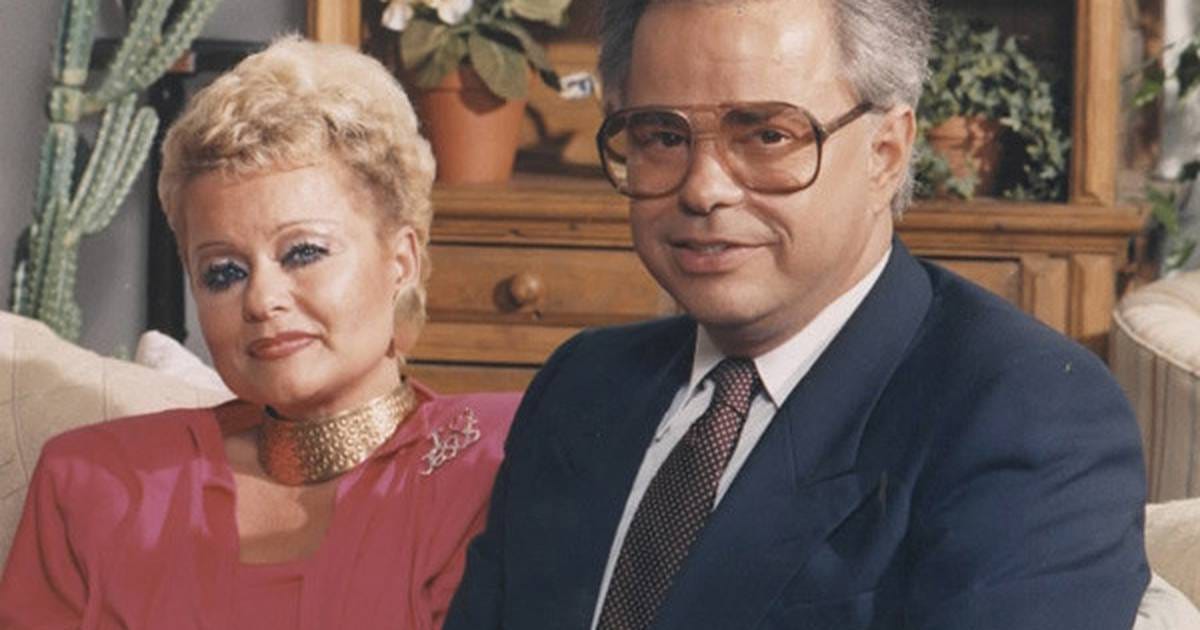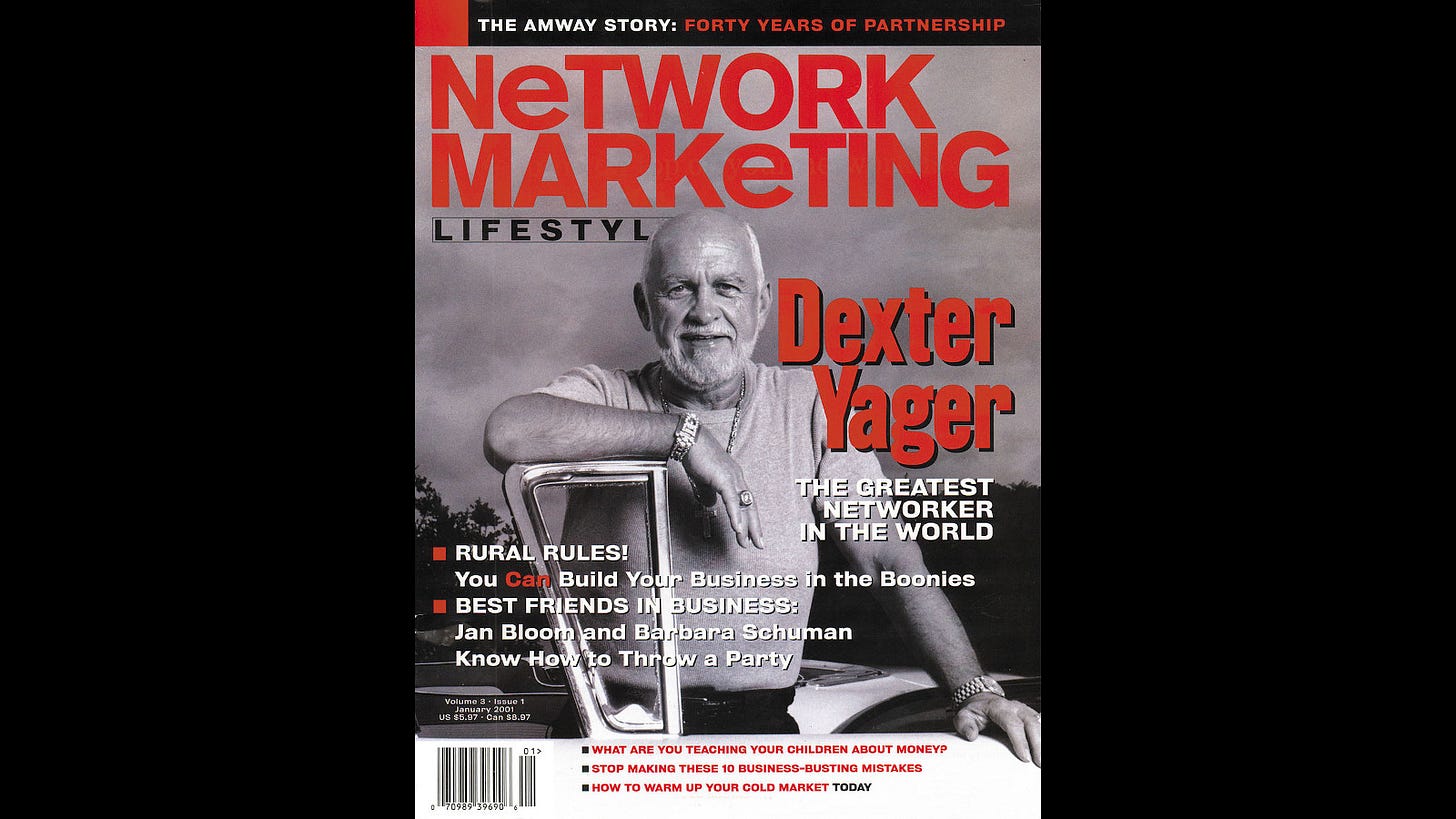The Tools Cult: The History of the Amway Motivational Scam. (Part 3 of 3)
This is the story of how a predatory multilevel marketing company tried to root out an even more predatory scam operating within their own ranks--and failed.
This series of articles is adapted from my in-depth video on the subject, available on my YouTube channel, link here. This is the final of three parts. Part one, released Sunday, is here. Part two, released yesterday, is here.
Miami Beach’s Fontainebleau Hotel—pronounced by locals as “fountain-blue”—is a famous local landmark. It was opened in 1955, was the site of a TV special with Frank Sinatra welcoming Elvis back from his tour in the Army, and was even featured in a James Bond movie. On April 5, 1983, a Tuesday, Amway representatives, including Ron Lindebom, Director of Sales for the Western region, and Bill Abraham, an attorney representing Amway corporation, met with a group of tools kingpins on an outdoor terrace of this hotel. Among the kingpins were Gerry Herrera, who controlled much of the tools business in Puerto Rico; Ron Hale, directly downline of Dexter Yager; Doug Wead, of course; and Dexter Yager and his wife Birdie. It’s unclear how many people were there. A roster of attendees would be a valuable thing, but I haven’t found it.
The ostensible purpose of the meeting was for the Amway corporate representatives to explain—try to explain—to the tools kingpins the legal danger that they were putting themselves, and the whole Amway ecosystem, in by profiting so egregiously from the tools cult. An ulterior motive may have been an entrée by the Amway corporation to try to find a way to share in the profits from that business. Certainly the kingpins perceived that’s what they were trying to do.
This extraordinary meeting was caught on tape. Though no longer available on the live web, an early blogger critical of Amway posted the recordings on his web site back in the 2000s and most (but not all) are still available on Archive.org.1 This tape is, in my opinion, the most illuminating historical source we have about how MLMs work from the top down. To my knowledge, no other source like this exists. It’s the equivalent of having a tape recording of a meeting of high-level Mafia bosses discussing big strategy. Because there’s such a cone of silence around the top levels of MLMs, and because in Amway particularly they are family businesses where no one talks and no one ever leaves, we have almost no other sources about how these things really work.
The tape of the Miami showdown is raw and unedited. You can hear airplanes going by overhead, for instance. The meeting was acrimonious—particularly at the beginning a bunch of people were shouting at each other. This is proof positive of the animosity between the ownership and policy heads of the two pyramids, the ostensibly legal Amway business and the legally-untested tools cult business.
Here are some of the most important bits.
Lindebom: “I’m sensitive to it!”
Unidentified 1: “They created two wars!”
Lindebom: “I’m sensitive to it!”
Unidentified 2 [Southern accent]: “That’s what looks like a smoke screen! Because we get it right now after the fact—”
Unidentified 1: “Because he says the BV was never meant to be competitive and on the last Directly Speaking tape, he says hopefully that will create some competition and so he’s contradicting himself!”
Doug Wead: “The corporation still tell us that these new rules BV on tapes is not going to take away from your tape business…then someone else from the company, or even the same person inconsistently says we got a legal problem, that’s why we got to take your tape business away! It’s, it’s, ah...”
Lindebloom: “We do have a legal problem but we don’t think it’s going to take your tape business away, or any other business! But, we’re gonna bring you, and I’m going to lead into Jim now because he’s going to have the most difficult time here...We’re sensitive to your hurt...No one has been thrown in the slammer...the attorneys, and they all seem to be somewhat of the same mind on this…”
These are admissions that the Amway corporation knew that most of the money was being made in the tools cult. Doug Wead referring to “BV on tapes”--BV is an Amway term meaning business volume, it’s how they calculate bonuses—but that refers to the kingpins’ fears that Amway is trying to get into the motivational tools business, and squeeze the kingpins out.
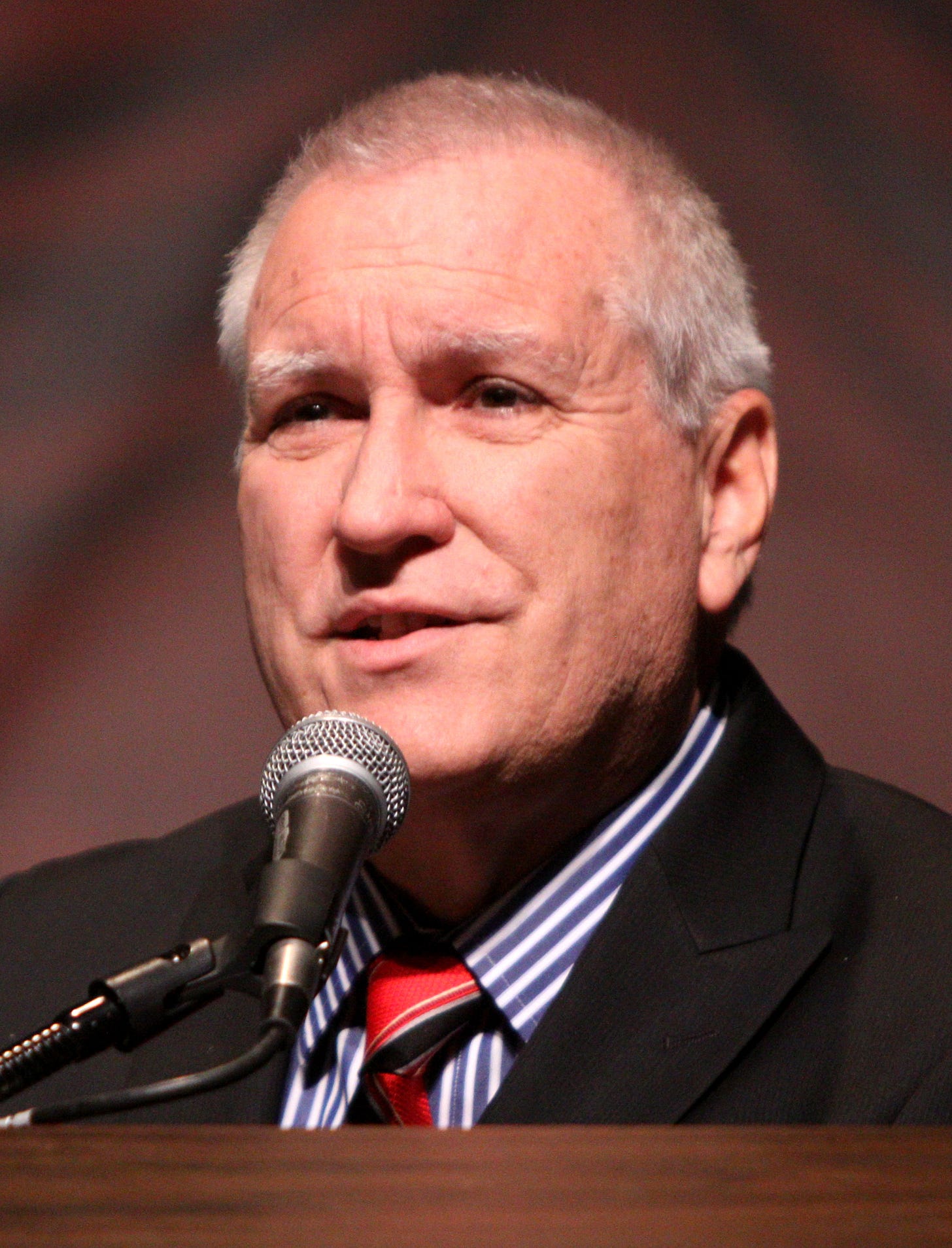
Lindebom: “What I’m hearing you say is, the decision was made to start to reap some of the rewards of the tape business, and I just got to say that is not, tell you that is not why the decision was made to put BV on tapes.”
Here’s the response, from an unidentified kingpin.
Unidentified 3: “But if that works, why split the company over it? Either it will work and you’ll get our tape business, or it won’t work…”
Lindebom: “The guy in the sunglasses—the guy in the sunglasses is going to clarify some of that!”
And this is the true smoking gun—the statement that proves that most of the Amway corporation’s profits are a result, indirectly, of the tools business.
Unidentified 4: “Ron, can I say one thing here, that I think that Doug [Wead] and Gerry [Herrera] have said here said that with the tape business ...The fact, the reason Amway is a, two-point, $1.5 billion...the reason it’s going to $2.5 billion, when I got into Amway it was $200 million. One of the biggest reasons it went to $200 million, or $1.5 billion, was seminars and rallies, was all the things in the Amway business, the seminars and rallies, the tapes and so on, that were voluntarily purchased, that were voluntarily gone to by distributors, and all of a sudden right now we perceive the company is strongly, whether it’s Rich and Jay, or whether it’s the company as a whole, strongly coming down on these things. And like somebody said here, is Rich really shooting for $1.5, or $2.5 billion, or $2.5 million, we’re somewhat confused! And, because does he really realize that if it wasn’t just to enhance the quality [unintelligible]...SA-8 is a great product, LOC is a great product, but it’s not going to stand alone.”
Lindebom: “I got you.”
Unidentified 6: “...as much money as we can get through the tape business, we wouldn’t have to, the money would be there build it, there’d be an incentive there to build it, but there’s no money.”
As much money as we can get through the tape business. There’d be an incentive there to build it, but there’s no money.
Then there’s this exchange, between Doug Wead, Yager’s protégé, and Amway lawyer Bill Abraham.
Doug Wead: “Would it be illegal to put more money in the plan?”
Bill Abraham: “Illegal? Put more money in the plan? Not to my knowledge. You got some kind of a hooker in that [indistinct]?...You mean for Amway to put more money in the plan?”
Wead: “[inaudible] could” or “maybe they could.”
The suggestion to put more money in the plan means, was it possible for the Amway corporation to tinker with its system, its pyramid-shaped structure, to make the actual selling of products and recruitment more profitable, so the kingpins wouldn’t have to get rich selling books, tapes and seminar tickets. But we know that couldn’t happen, because if Amway tinkered with the plan, it would have run the risk of crossing the very fine red lines the FTC drew around it in the 1979 decision—the only thing that kept the whole empire technically legal.
So what’s the fix? Ron Lindebom, one of the Amway suits, gave a directive that clearly came from the lawyers and was based on the FTC decision.
Ron Lindebom: “Be sure to insure that tools do not grow to such a level that they can no longer be described as reasonably related to the sale of the product to the ultimate consumer. What’s reasonable? I don’t know...”
Why is this important? Because if the kingpins were making money from something other than the sale of products to direct consumers, they were involved in an illegal pyramid scheme. The FTC could renew its assault, by claiming Amway violated the terms of the 1979 decision, and the whole enterprise would have gone the way of Koscot and Holiday Magic. This is what the Amway suits were afraid of.

Late in the meeting, Amway’s lawyer, Bill Abraham, stressed this point. But he also seized the opportunity to make a political statement, which shows how the Amway corporation, and the kingpins, saw themselves.
Bill Abraham: “With this situation, you can’t give up your income because if you did it’d mean Chapter 13 or bankruptcy court...How do we satisfy Amway’s desires and commands? Because they’re running scared. And they are running scared. They’re running scared because they’re confronted with the enemy, and the enemy happens to be the liberals of this country at the moment who are in office. And those liberals are out there to try to find any nit-pickin’ thing they can find to try to make you look like what you’ve always branded, as an unlawful pyramid, a chain letter, a wholesale buying club…”
Throughout the meeting, Dexter Yager was uncharacteristically quiet. His wife Birdie spoke up more often than he did. But after a while he did finally chime in with how he saw the situation.
Dexter Yager: “The corporation’s over here, and we’re over here, and we feel that we got something really going, we can work it out, we can smooth it out we’ll do whatever it takes to make it happen, as long as we can get back to having some kind of love relationship and a mutual respect and that seems to have been thrown aside by both sides and we’re almost acting like rejected lovers.”
The end of the meeting was cordial. The kingpins praised and thanked the Amway suits for coming; they promised they’d work together; kumbaya and all that. It reminded me a bit of the gangsters embracing each other at the end of the summit meeting in The Godfather. There was another meeting later that day at the same hotel, much more scripted, in a hotel ballroom between the Amway suits and the lower-level tools cult participants, called the Emeralds. There are far fewer juicy revelations on that tape, probably because that group operated at a lower level; and in any event that tape is incomplete.
So what, if anything, was accomplished at the Miami showdown? Unfortunately we don’t know. The only way we know about the showdown itself was because this tape managed to surface back in the early 2000s. There must have been other meetings, other damning memos; but we haven’t seen or heard any of them. As I said early on, these organizations are as secretive as the Mafia, with a cone of silence surrounding nearly everything they do. All we know is the ultimate result of the battle between the Amway corporation and the tools cult kingpins. The corporation surrendered.
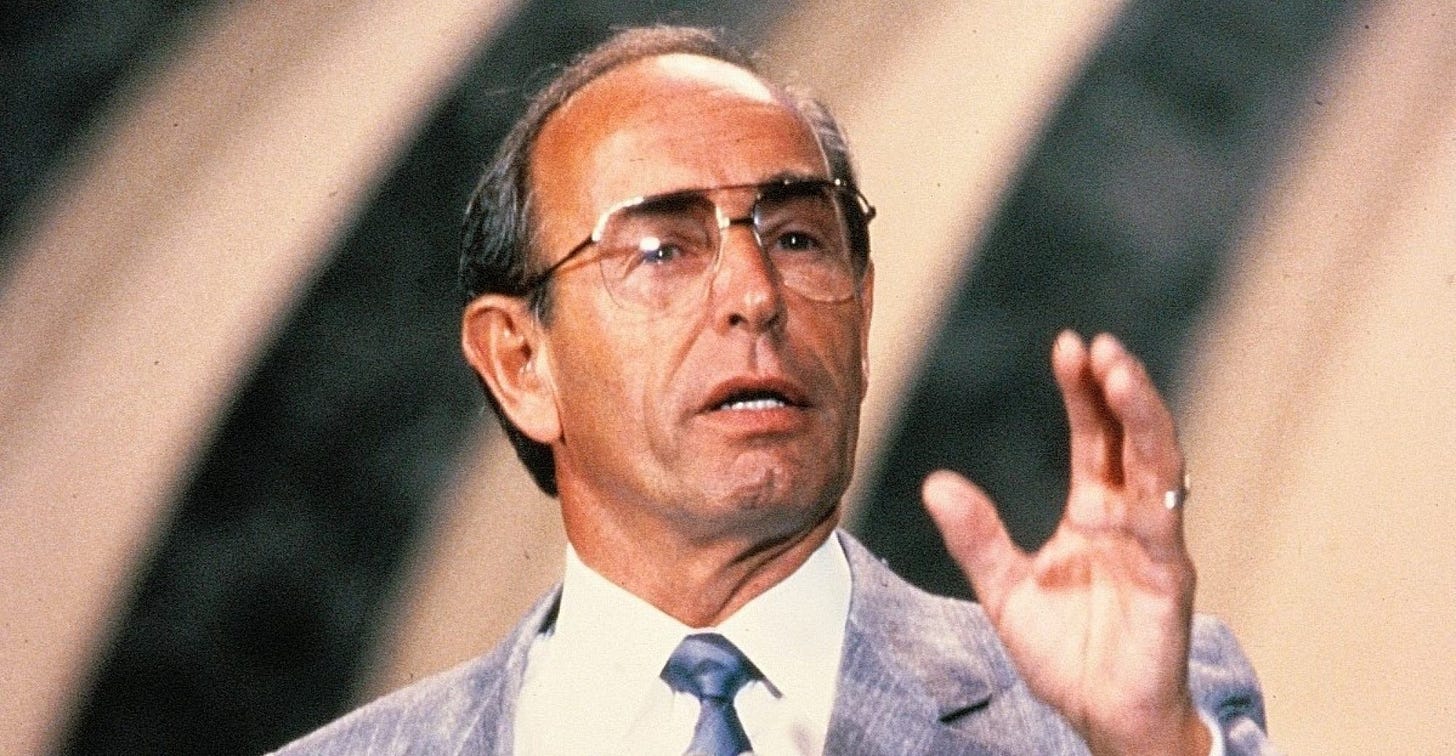
Amway Surrenders to the Kingpins
By the late 1980s, lawsuits against Amway, and the tools cult kingpins, were beginning to pile up. Most were from Amway distributors who sued their uplines to try to get let into the tools cult business—to break into the walled garden, in other words. Some were from former distributors who felt they’d been cheated by the kingpins in one way or another, or blamed the Amway corporation for not reining them in.1
Rich DeVos, co-founder of Amway, testified in one of these cases in 1988, and made a startling admission about the Miami Showdown and the conflict with the tools kingpins. From the sources it’s unclear exactly which case the exchange occurred in. But here is the Q&A from that proceeding.2
Q (lawyer). “What happened in the area of the tools abuses, the private tools abuses addressed at that meeting?
By “that meeting,” the lawyer is referring specifically to the Miami showdown.
DeVos. “Well, those abuses continued to this day, There are a variety of people who complain to me continually about some of those abuses, so that's an ongoing challenge that the organization faces...I said to some of our staff there that I thought that it would cost us a few hundred million dollars in volume—I think I said $300 million—as we went through a correction phase...I think we lost upward of $300 million in volume as we tried to go through this adjustment period.
Q. “It is a position that you took in the early part of 1983. Have you deviated from that position in the Amway Corporation since then, with respect to your Ten Points and the subject matter contained therein?
DeVos. “Well, let's just say that we dealt with it the way we did. We did put some people under notice that they were doing things wrong. We pursued of course re-education but we never pursued it to its ultimate goal of really nailing anything down. In the meantime, the volume came down and we started to work at trying to hold the business together but the problem persisted in any case.”
This is all we really know about Amway’s surrender, but if you zoom out, at a macro level the dynamics of the decision is clear. The Amway corporation realized that a significant portion of their income came from the downlines of the tools kingpins—all those distributors, hooked on tapes and rallies, buying LOC and SA-8 soap. Revenues were already declining in 1982 and 1983. Amway provoked a conflict with the kingpins, who thought the company was trying to horn in on the tools cult profits. Faced with the backlash at the Miami showdown, a decision was made to back off, maybe issue a few warnings, but not really follow through. After all, the company was already bleeding $200 million from what little they did try to do; evidently the suits decided they couldn’t risk heavier losses.
And what about the FTC, the Sword of Damocles that hung forever over this entire ecosystem of grift? Amway apparently decided they simply had to hope for the best—that the FTC wouldn’t renew the assault and go after the pyramid scheme run by the kingpins. This gamble was probably reasonable when it was made in 1983, and certainly proved so over the succeeding decades. As both the Amway corporation and the tools cult kingpins increased their wealth and their political power, they were able to not only insulate themselves pretty effectively from another assault by the government, but they were also able to advance the broader political and ideological project that the entire Amway ecosystem was, at least in part, created to build.
The Tools Cult and Politics
We’ve already seen the political nature of the Amway enterprise. With a handful of exceptions Amway distributors who rise high in the business are, and have historically been, conservative Republicans. I profiled Doug Wead, tools kingpin and pipeline from the religious right to the Bush family, in part II of this series. In addition to him, it’s worth exploring briefly the ties between the tools cult and the broader project, afoot beginning in the 1970s, to turn America’s politics sharply to the right, and to entrench and broaden the power of evangelical Christians in particular.
Dexter Yager was a member of an organization called the Full Gospel Business Men’s Fellowship International (FGBMFI). This was a hard right-wing Christian organization, based in the Pentecostal Evangelical movement that expanded throughout the South in the 1950s that essentially built the ideology we now call Prosperity Gospel. Others in this same organization, or connected to it, included Oral Roberts, the Osteen family (including today’s Joel Osteen), and televangelist Jim Bakker—who became a close friend of Dexter Yager. In fact, Yager was something of a mentor to Jim Bakker, who began to incorporate the style and messaging of the Amway motivational tools into his own efforts to spread politically conservative, capitalist-oriented Christian gospel, particularly through the medium of television.3
In the mid-1970s, after his falling out with Pat Robertson’s Christian Broadcasting Network in California, Jim and Tammy Faye Bakker moved to Charlotte, North Carolina, which is where they founded the televangelist PTL Ministry. One of the factors that drew them there was Yager’s presence in the Charlotte community. Yager himself later sat on the board of PTL. A historian who studied Bakker’s life and career analyzed the televangelist’s relationship with Dexter Yager like this.
Bakker was especially interested to learn how to apply Yager's inspirational messages and techniques to his own ministry. In fact, he was so enthralled with Yager that he became an Amway sales associate and attended weekly meetings with Yager, Doug Wead and other important members of the Amway organization. These meetings and the connections with Amway and with Yager inspired Bakker to make prosperity theology an even more important part of his ministry and he began to learn from Yager how to market and sell his message. Yager, meanwhile, endorsed PTL and encouraged his distributors to support Bakker's new network. He also liked to flaunt his own success with PTL employees by walking around the offices with a shoulder satchel containing $20,000 of "pocket money."4
PTL and Jim and Tammy Faye were part of a larger movement that grew in the mid-1970s. This movement, in which politically conservative evangelicals were prominent, was a backlash to the cultural and economic liberalism of the 1960s—LBJ’s Great Society, the protest against the Vietnam War, and particularly the phenomena of second wave feminism and the LGBTQ liberation movement. This counter-reaction would manifest itself later in the decade with the foundation of The Moral Majority, Jerry Falwell’s political action organization. This galvanizing of the Christian right wing was instrumental in propelling Ronald Reagan to the White House in 1980. Seeing it all in context, doesn’t it make sense that Doug Wead, another of Dexter Yager’s proteges, wrote Reagan’s campaign biography? It makes sense, doesn’t it, that Reagan spoke at an Amway convention organized by Dexter Yager? The tools cult was not just a way to make vast amounts of money, though it clearly was that. It was also a political and ideological project to remake America.
There’s an environmental component to this too. Part of the new consciousness that developed in the 1970s involved an understanding that America had limits—ecological and environmental limits to consumption, to pollution, and ultimately to profits. To true believers in the ideology of capitalism, any hint of limits, ecological or otherwise, were unacceptable. Part of the core beliefs of the Full Gospel Business Men’s Fellowship International, the organization to which Dexter Yager and Jim Bakker belonged, was that the American dream was embodied by economic growth and personal prosperity—and that these things were also core tenets of Christianity.5
So the dreams promised by the tools really were the point. It really was about the coach, the boat, the mansion and the fur coats—the stuff Amway believers were instructed to cut out pictures of and put on their refrigerators to remind themselves of what they’d have on that magical day they “go Diamond.” Fused together with the politics and the theology of prosperity gospel, Amway itself becomes something righteous and holy, and anyone outside the cult is an enemy.
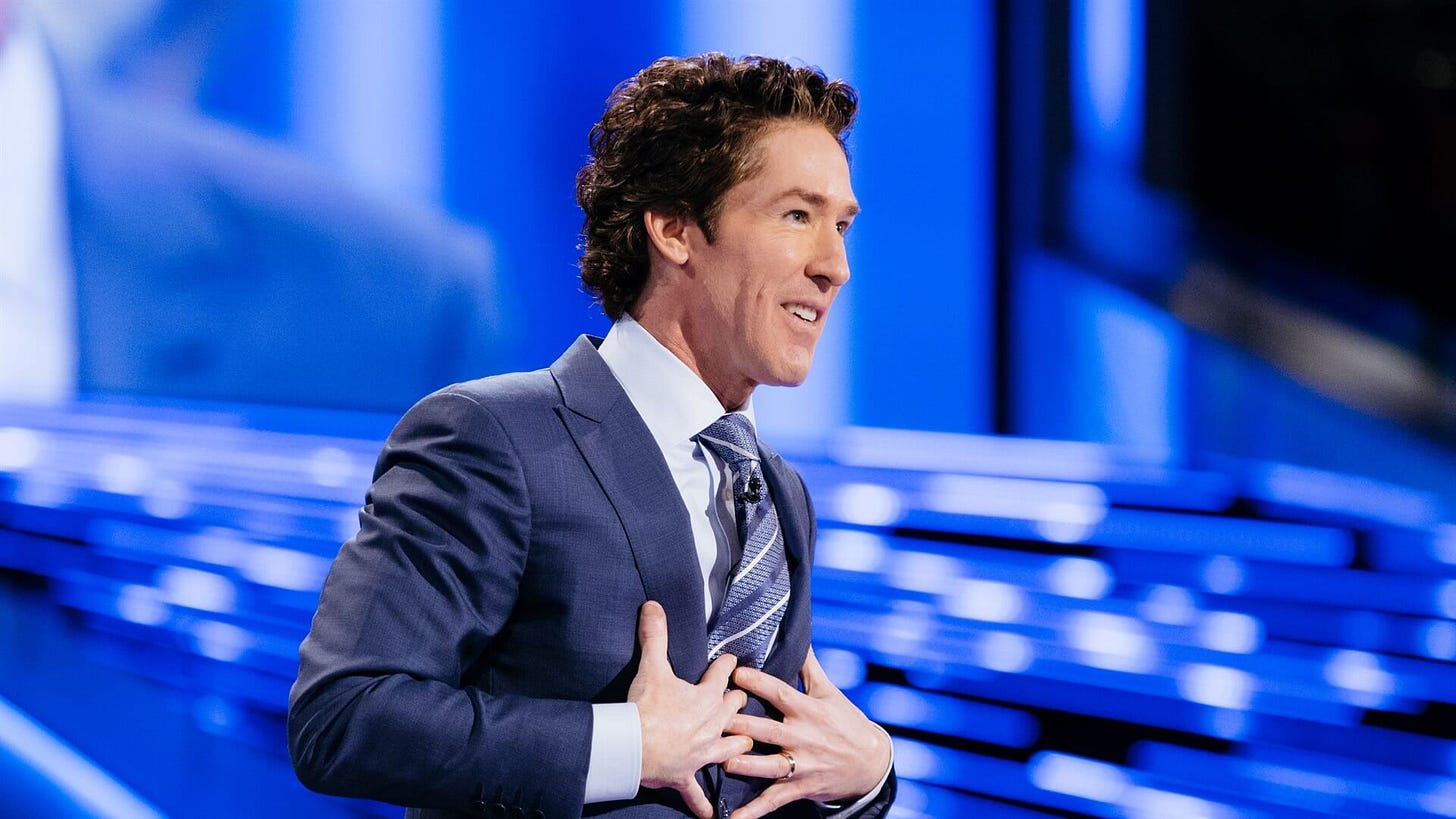
It wasn’t just politics and economics. As the hold of the Christian right wing over America tightened in the 1980s and 1990s, homophobia became one of the major characteristics of their movement—and a major policy plank of the Republican Party. After 1991, there was no more Soviet Union, and the specter of global Communism was no longer available as a punching bag and unifying threat for the conservative right. Some gay leaders argue that hatred of the LGBTQ community began to replace anti-Communism as the galvanizing ideology within the American conservative movement—more powerful, even, than their opposition to abortion rights.6
It should come as no surprise that, on the many thousands of hours of tapes that exist of Dexter Yager extemporizing, particularly at those supercharged Amway rallies at packed stadiums, there are homophobic statements condemning the LGBTQ community and criticizing the so-called gay lifestyle. Yager’s attacks on the LGBTQ community had a political component too. In the 1990s Yager attacked Hillary Clinton, a favorite target of the right wing, as a lesbian, and charged that the Secret Service brought her lesbian lovers into the White House—a story, common in the anti-Clinton conservative fevers swamps of that era, which he told to 5,000 Amway distributors of the Fred Harteis organization, itself a spinoff of Yager’s line. Because, of course, being a Democrat, and being a lesbian, were comparable sins in the politicized Christian worldview of the Amway tools cult.7
In March 1987, Jim Bakker was brought down as head of the PTL Ministry in a series of scandals in which he was accused of diverting funds from his ministry to pay blackmail money to his mistress, Jessica Hahn. When the story broke, Bakker went into hiding to avoid the press and also his aggrieved wife, Tammy Faye. Where exactly did he go to hide? A guest house on Dexter Yager’s estate.8 Jim Bakker eventually went to prison for fraud and conspiracy.
Conclusion
Most of the major participants in our story are gone now. Bill Britt, the first to mass produce tools cult tapes, died in Ponte Vedra Beach, Florida, in January 2013. In the latter part of his career he concentrated heavily on building Amway downlines and spreading the tools cult to India. He seems to have had a falling-out with Dexter Yager at some point, but I did not spend much time researching that. Doug Wead, who documented the birth of the tools cult and certainly profited from it, passed away in December 2021. Jay Van Andel, co-founder of Amway corporation, died in December 2004; his partner, Rich DeVos, passed away in September 2018. The master kingpin himself, Dexter Yager, died peacefully at his home in Charlotte, North Carolina on January 6, 2019. There are numerous tributes to him on the web, many from obvious acolytes of the tools cult, who still speak of him effusively and parrot the bromides he spent decades delivering.
The tools cult continues on to this day. It remains a major focus of the criticism directed at the Amway phenomenon as a whole, particularly from the anti-MLM movement. The legality of the tools business remains officially untested by the FTC or federal courts. The advance of the broader political and social project of the Amway cultiverse, and the increasing share of the American economy that’s tied up in ever-multiplying MLM grifts, leaves me skeptical that there will ever be any meaningful official action to disrupt these organizations.
Historically, in my opinion, there needs to be a lot more attention paid to this story, which I believe lies at the heart of the history of American business, economics and politics in the past 60 years. In my view, the fact that Dexter Yager, love him or hate him, is not recognized as one of the most important and influential people in recent American history, is astonishing. But now you know the story: the incredible truth about one of the largest grifts in U.S. history. The fact that it has no ending—that it’s still going on—should make all of us question the values of an economy and a political system that allows such deceptions to flourish, and to prey on people decade after decade.
Sources
1See, e.g., Cairns et al., v. Amway et al., discussed in Juth-Gavasso, Carol Lynn, "Organizational Deviance in the Direct Selling Industry: A Case Study of the Amway Corporation" (1985). Dissertations 2316, pp. 184-190 (https://scholarworks.wmich.edu/dissertations/2316).
2“Amquix.Info’s Additions to Dateline NBC,” Amquix.info (defunct), (https://web.archive.org/web/20060422025339/http://www.amquix.info/dateline/dateline.html).
3Eric G. Weinberg, "Creating Heaven on Earth: Jim Bakker and the Birth of a Sunbelt Pentecostalism," Theses and Dissertations—History 7 (2012), pp. 92-96 (https://uknowledge.uky.edu/history_etds/7)
4Ibid., 95-96.
5Ibid., 113.
6Harkavy, “The Tangled Roots of Doug Wead” (https://www.villagevoice.com/2005/02/21/morning-report-22105the-tangled-roots-of-doug-wead/).
7Eric Scheibeler, “Case Studies/Dexter Yager,” MerchantsofDeception.com (defunct), (https://web.archive.org/web/20050407043804/http://www.merchantsofdeception.com/casestudies.html).
8Weinberg, p. 184.
☕ If you appreciate what I do, buy me a virtual coffee from time-to-time to support my work. I know it seems small, but it truly helps.
📖 You could also buy my book, which I wrote in part to take my mind off climate anxiety.
🎓 Like learning? Find out what courses I’m currently offering at my website.
📽 More the visual type? Here is my YouTube channel with tons of free history videos.
💌 Feedback to share or want to say hello? Hit reply on this email or leave me a comment on Substack.







